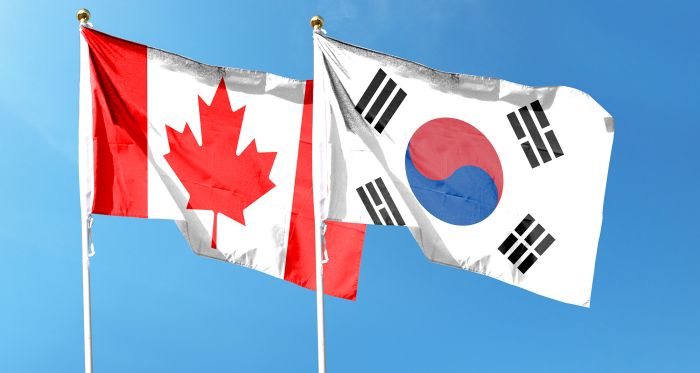Why This Anniversary Matters
The year 2025 marks the 10th anniversary of the Canada-Korea Free Trade Agreement (CKFTA), which came into effect in 2015. This milestone arrives amid heightened uncertainty from intensifying tensions between the United States and China, shifting supply chains, and renewed protectionist pressures from Washington. In this context, the CKFTA is more than a trade deal: it represents Canada’s first bilateral FTA with an Indo-Pacific partner and serves as a strategic anchor for Canada’s broader regional engagement. Over the past decade, the agreement has expanded commercial opportunities and strengthened institutional linkages with South Korea, supporting Canada’s heightened presence in the region.
A Decade of Growth
Since the CKFTA entered into force, trade in goods between Canada and South Korea has doubled (Figure 1). Specifically, Canadian merchandise exports grew from just over C$4 billion in 2015 to C$7.6 billion in 2024, while imports from Korea rose from C$8.2 billion to C$16.9 billion during the same period. This expansion reflects not only the impact of the near-complete elimination of tariffs — covering 93 per cent of Korean exports and 99 per cent of Canadian exports — but also deepening sectoral complementarities between the two economies.
Preliminary data from 2025 suggests that this trajectory has continued. In the first half of 2025, Canadian exports to Korea reached C$8.2 billion, already surpassing the 2024 full-year figure, while imports from Korea stood at C$3.7 billion. These half-year figures should be interpreted cautiously but indicate that bilateral trade is set to reach another record high in 2025.
Exports by sector
Canada’s exports to South Korea between 2015 and June 2025 were highly concentrated in a few key sectors, led overwhelmingly by mineral products. Ores, mineral fuels, and related resources together account for 57 per cent of Canada’s total exports to South Korea, underscoring the market’s role as a major destination for Canada’s resource economy. Agricultural products — including meat and seafood — form the second pillar (12 per cent), while machinery, electrical equipment, and wood products make up most of the remaining trade. In short, Canada’s export profile to South Korea remains resource-heavy, with gradual diversification into higher-value manufactured goods.
Canada’s imports from South Korea are heavily concentrated in advanced manufacturing (Figure 3). From 2015–25, vehicles alone accounted for nearly half of all imports (44 per cent, C$48.8 billion), followed by machinery (17 per cent, C$18.8 billion) and electrical equipment (12 per cent, C$13.6 billion). These three categories together account for almost three-quarters of the total share of high-technology and industrial goods. Iron and steel products form the next largest group, with chemicals, plastics, and pharmaceuticals making up most of the remainder. This profile highlights South Korea’s competitive strength as a supplier of transportation equipment and high-value manufactured goods to Canada.
Services trade
The two-way services trade between Canada and South Korea has grown steadily since the signing of CKFTA, reaching C$2.5 billion in 2023, up from C$1.8 billion in 2018. Canadian service exports have nearly doubled over the past decade (C$1.1 billion in 2015 to C$1.9 billion in 2024), consistently producing a large and growing trade surplus in services. Two main sectors have driven this surplus: travel and commercial services. South Korean visitors’ spending in Canada remains the largest contributor to this sector and has rebounded strongly since the pandemic, nearly back to pre-2020 levels. Commercial services — such as professional and technical services — provide a stable, year-round source of surplus. Together, these sectors underline the resilience of bilateral services trade and the growing importance of people-to-people and knowledge-based exchanges in Canada–Korea economic relations.
Province-level patterns: British Columbia leads, with Alberta rising
Canada’s exports to South Korea are highly concentrated in four provinces — British Columbia, Quebec, Ontario, and Alberta — which together account for over 90 per cent of the total. B.C. has consistently dominated, contributing nearly half of all exports thanks to its Pacific gateway ports and wealth of natural resources. The province’s exports to South Korea have nearly doubled since 2015, supported by tariff reductions, trade promotion efforts, and deeper institutional ties. B.C.’s exports remain anchored in mineral fuels, ores, and forestry products, positioning the province as Canada’s key conduit for resource trade with Northeast Asia and as the emerging hub for liquefied natural gas (LNG) exports.
Meanwhile, Alberta has emerged as a dynamic player in Canada-Korea trade. Its exports surged in 2022 to C$1.5 billion — briefly overtaking Quebec and Ontario — when South Korea scrambled to secure alternative LNG supplies amid the energy shock following Russia’s full-scale invasion of Ukraine that year. While this spike was partly price-driven, Alberta’s growing share of total exports since 2024 points to a more sustained reorientation of Canada’s energy trade with South Korea.
Quebec and Ontario add diversity to the export mix. Quebec combines ores, pulp, and other resource exports, alongside shipments from its world-class aerospace sector. Ontario exports machinery, optical instruments, and critical minerals — inputs that are central to South Korea’s advanced manufacturing and battery industries. Together, these provincial profiles reveal a trade relationship shaped by both Canada’s resource endowments and its emerging role as a supplier of high-value industrial components, suggesting a mix of continuity and new opportunities under the CKFTA framework.
Taken together, the past decade shows a clear trajectory. Canada–Korea trade has grown steadily, broadened across a wider range of sectors, and has become anchored in a mix of resources, energy, and high-value industrial goods. This concentration reflects both structural complementarities and emerging opportunities in critical minerals, LNG, and advanced manufacturing, showing that the opportunity offered by the CKFTA is much more than just a cut in tariffs. It is a strategic platform for both Canada and South Korea to navigate global disruptions and for Canada to strengthen its Indo-Pacific presence.
CKFTA’s Strategic Role amid Global Disruption
1) Protectionism and Trade Fragmentation
Global trade has entered a turbulent phase marked by renewed protectionism and supply chain fragmentation. For Canada, this new environment raises the stakes for trade diversification and securing stable, rules-based access to alternative markets. The CKFTA provides a dependable framework that shields Canadian exporters from sudden tariff shocks and helps preserve market share in one of Indo-Pacific’s most competitive economies.
Case 1: Pork Exports
Canadian pork products have been one of the biggest beneficiaries of the CKFTA. In 2024, Canada was South Korea’s fourth-largest meat supplier, shipping nearly C$535 million in meat products — most of which was pork — representing a 26 per cent compound annual growth rate since 2020. Tariff reductions under the CKFTA have been crucial in keeping Canadian pork competitive against U.S. and EU suppliers, allowing Canadian producers to expand market share despite volatile global demand and protectionist pressures.
Case 2: Canola Oil Exports
Canadian canola oil has maintained a steady foothold in South Korea’s rapidly growing cooking oil market; in 2023, Canada was South Korea’s fourth-largest supplier of cooking oil, shipping roughly C$67 million. Despite price volatility caused by climate events and the Russia–Ukraine war, Canadian canola remained competitive thanks to CKFTA tariff preferences, which have reduced or eliminated duties on most oilseed products. This stability reinforces Canada’s role as a reliable supplier of high-quality oils in a market where consumers remain price-sensitive but increasingly value consistent, safety-approved imports.
2) Technological Shifts and the Digital Economy
Rapid advances in AI, automation, and advanced manufacturing are reshaping global competitiveness and trade flows. Within the CKFTA framework, Canada and South Korea have an opportunity to deepen collaboration on digital trade, AI governance, cybersecurity, and next-generation technologies.
This shift is already visible in industry-led partnerships. Toronto’s Tenstorrent, backed by Samsung Securities, is co-developing AI chiplets in collaboration with BOS Semiconductors, signalling deepening integration between Canada’s AI hardware sector and South Korea’s semiconductor ecosystem. Similarly, Ottawa-based Kinaxis has partnered with Samsung Electronics, deploying its RapidResponse AI platform to optimize Samsung’s global supply chains. These cases show how bilateral collaboration is moving from policy dialogue, such as the Canada–Korea Track 1.5 Dialogue on Artificial Intelligence in 2025, to concrete, high-value industrial projects that position both economies to compete in a more digitized global marketplace.
3) Energy Security and Green Transition
Energy security and the green transition have emerged as central pillars of Canada-South Korea co-operation under the CKFTA framework. South Korea, the world’s third-largest LNG importer, faces an urgent need to diversify energy sources and reduce dependence on geopolitically exposed suppliers. Canada, meanwhile, is developing LNG export capacity on its west coast, positioning itself as a reliable long-term supplier. A flagship example is the Woodfibre LNG in B.C., which has secured South Korean buyers for long-term contracts — an early sign that Canada could become a more regular player in South Korea’s energy market.
Beyond LNG, the two countries are aligning on next-generation energy cooperation. In 2023, Canada and South Korea signed MoUs on critical minerals and clean hydrogen supply chains, linking Canadian mining projects with South Korea’s EV and battery production ecosystems. These initiatives mark a shift from transactional energy trade to strategic supply chain integration, embedding Canada more deeply into South Korea’s industrial decarbonization plans and positioning both countries to benefit from the global green transition.
4) Supply Chain Resilience
Supply chain resilience became a defining priority in the aftermath of pandemic disruptions, Russia’s invasion of Ukraine, and climate-driven shocks that have exposed the vulnerability of global production networks. The CKFTA offers a rules-based framework for deepening Canada–Korea supply chain integration in critical sectors such as semiconductors, battery materials, and agri-food.
One example is a 2024 investment by South Korea’s POSCO Holdings in a Canadian lithium project, developed in partnership with Invest Alberta, to secure upstream EV battery materials. Co-operation is also expanding downstream: NextStar Energy, the LG Energy Solution–Stellantis joint venture in Ontario, began mass production of battery modules in late 2024 and is on track to start cell production in 2025. Together, these investments illustrate how South Korean firms are embedding themselves across Canada’s battery supply chain, from mining to manufacturing, strengthening supply security while advancing Canada’s ambition to become a trusted partner in global clean energy transitions.
The Next 10 Years
South Korea’s potential accession to the Comprehensive and Progressive Agreement for Trans-Pacific Partnership (CPTPP), the 12-member agreement of which Canada is a founding member, would open additional opportunities for alignment. Canada could use the CKFTA’s existing provisions as a bridge to ensure seamless integration, preserving preferential access for Canadian businesses while harmonizing new commitments under the CPTPP. Doing so would secure continuity and reinforce Canada–South Korea co-operation within a broader, rules-based regional trade architecture.
The next decade of the CKFTA will be defined less by tariff elimination and more by its role as a platform for upgrading strategic bilateral co-operation. Both Canada and South Korea are well-positioned to deepen collaboration on critical minerals, advanced technologies, digital trade, and green energy. Targeted sectoral agreements, building on the CKFTA framework, could transform the agreement into an institutional platform for innovation-driven growth and energy transition partnerships.
The CKFTA will also continue to serve as a valuable template for Canada’s Indo-Pacific diversification strategy. As Canada’s first bilateral FTA with an Indo-Pacific partner, the agreement demonstrates how trade agreements can advance both economic and strategic objectives. Leveraging its success, Canada can use the CKFTA as a model for integrating trade liberalization with supply chain security, energy resilience, and digital economy co-operation more extensively in the region.
• Edited by Erin Williams, Director, Programs, Vina Nadjibulla, Vice-President Research & Strategy, and Ted Fraser, Senior Editor, APF Canada. Graphic Design by Chloe Fenemore, Senior Graphic Designer, APF Canada.




